For the last few weeks – the last few months, really – there has been much catastrophizing that the election might be all but lost for Democrats, given President Biden’s already-poor poll numbers before the disastrous debate, especially with young voters and voters of color. Now, Biden has made the right and patriotic choice to withdraw from the presidential race; as this post will indicate, it does improve our chances to defeat Trump. With Biden’s endorsement of Kamala Harris (and an avalanche of other endorsements from prominent Democrats, including some potential rivals for the nomination), she seems most likely to be the new Democratic nominee.
However, we are some time away from having reliable polling data pitting the eventual Democratic nominee against Trump. Moreover, we need to resist the temptation to take the initial polls at face value – whether they are good or bad. We are in such uncharted waters that literally no one has experience polling a last-minute change in nominees, much less one who will run against a thrice-nominated former president, convicted felon, and immunized insurrectionist. But, we don’t need polls to tell us what we need to do to defeat Trump and MAGA fascism.
A “MAGA Election” or a “Normal Election”?
Instead of making much ado about who, it’s time to make much ado about what the stakes of this election are. While the person at the top of the Democratic ticket will matter, it is secondary to the factor that will most determine whether or not Trump wins in November: what voters think this election is “about” in October.
There are two basic possibilities for what the election will be “about.” We could have what I call a “MAGA Election,” where the election is “about” what Trump will do if he is returned to the White House, and how his MAGA allies on the Supreme Court and Project 2025 will help him do it. Or we could have what I call the “Normal Election,” where the election is “about” anything else – Democrats’ governing record, crime rates, “the economy,” you name it.
If it’s a MAGA Election, Trump will almost certainly lose. If it’s a Normal Election, Democrats will almost certainly lose. But that’s something we can collectively influence. By “we,” I mean everyone who wants to stop American fascism – not just Democratic campaigns, but also civil society, the free press, and everyday Americans. I’m not saying we have nothing to worry about, or that we don’t have a big task ahead of us; far from it. This is a task we have risen to before, and a task we know how to complete.
This post will explain why I am so confident this is the case. It will also more generally try to make sense of where the race is now, what we can expect, and why.
Here are some of the most important points I’ll cover in more detail in this post:
-
The 2022 midterms were a striking natural experiment that showed the difference in outcomes between a MAGA Election and a Normal Election. I’ve made this case before in “Red Wave, Blue Undertow.” Today, I will present new evidence that strongly indicates it was the stakes of the election – not other factors such as demographics, vote history, or partisanship – that made the difference between Democratic wins and losses in 2022. (Section I)
-
The anti-MAGA majority is as solid as ever, but not consolidated behind Biden or Democrats. But they don’t support Trump either. Trump is doing no better in the polls now than he was four years ago. Disaffected anti-MAGA voters constitute the majority of the voters that Biden had in 2020, but that he doesn’t have in the most recent polls, and also represents many of those who didn’t vote in 2020 and are not currently supporting either candidate. (Section II)
-
A MAGA Election – one where the stakes of electing MAGA are clear and credible to voters – results in Democratic wins because it motivates America’s anti-MAGA majority to turn out. For the last three cycles, the success of the anti-MAGA majority has depended on historically high turnout and lopsided opposition from young voters and voters of color – the demographics Biden had lost the most ground with in polls. However, these voters were never really “for” Biden or Democrats generally; in fact, they are much more likely to think the country is on the wrong track and lack confidence in Americans institutions and political leaders. But since 2018, they have been motivated to turn out by loss aversion – fearing (correctly) that they could lose their freedoms if MAGA wins.1 (Section III)
Thus, the most important misapprehension in the conventional analysis is that Democrats have been doing well in recent elections where they have overperformed because regular voters have become more Democratic. In fact, Democrats have been doing well because voters who are disenchanted with the political system, but reject the MAGA agenda, have been voting more often. (For more, see “A Cure for Turnout Terror.” )
It’s worth revisiting what Ezra Klein said when he argued in February for Biden to step aside: “If you think Donald Trump is going to win, you have to do something about it. Otherwise, you’ve kind of just been lying to people and lying to yourself.” As I’ve been writing for years, for the most part, Democrats have been effectively lying to themselves and their voters about the urgency of the crisis we face. They have continuously undermined the power of their all-too-accurate warnings about the dangers of Trump and MAGA fascism by doing too little, too late, and by shirking from the uncomfortable. Biden’s decision to step down does a great deal to redeem the Democratic Party on this front.
Subscribe to Weekend Reading
We Are Not Hungary
Many commentators have pointed to horse race polls to argue that Trump has been “Cutting into Biden’s Lead” with younger voters and voters of color, and that this proves America is undergoing a historic political realignment. Many fear that this realignment portends America falling prey to the same autocratic trends that have compromised or toppled democracies in Hungary, Turkey, and elsewhere.
However, neither Trump nor the MAGA agenda are becoming more popular – in striking contrast to the ethno-nationalist dictators Trump is compared to when those dictators were elected to office. Consider:
-
In Hungary, Orbán’s Party had a 33 point margin in the parliamentary elections;
-
In Turkey, Erdoğan was directly elected in 2014 to presidency with a 13.35 percent margin;
-
In India, Modi's party won by a 11.7 percent margin in 2014 when he was named Prime Minister;
-
In the Philippines, Duterte's margin was 15.57 percent in 2016; and
-
In Italy, Berlusconi's party's margin was 13.3 percent in 1994 when he first came into power.
But, in the United States, Trump has lost the popular vote twice, and in the 9 years since he descended his golden escalator, has never won the approval of a majority of Americans.2
However, sit with this: The voters in the “Red Nation” slice of our country preferred Donald Trump (twice) to Hillary Clinton or Joe Biden by a greater margin than any president in our lifetime has won by, other than Reagan, Nixon, and Eisenhower. At the same time, Clinton and Biden defeated Trump by two dozen points in “Blue Nation” states – and there is not a single ethno-nationalist MAGA Republican holding a state-wide office in any Blue State, where more than a third of Americans live.
I. A Tale of Two 2022 Midterms: One With, and One Without, the Anti-MAGA Majority
When people believe the MAGA threat is real, they are more likely to cast a ballot. Again, the reason it seems “frequent voters” are more Democratic now is that Democratic-leaning people are voting more frequently. However, they are doing so if and only if the threats of MAGA winning are clear and credible. To support this finding, in this section I’ll dig into the voter file to rule out other possible confounding factors – further corroboration that the “Red Wave, Blue Undertow” pattern in the 2022 midterm was, in fact, caused by the salience of the MAGA threat.
The 2022 midterms provide the most important evidence that MAGA loses when these anti-MAGA new voters vote, and MAGA wins when they don’t. Not only did MAGA lose nearly across the board in the Electoral College battleground states in 2022, they lost because those new voters turned out at a much higher rate in those states than they did elsewhere in the country. And, indeed, in the states where Democratic underperformance was greatest — California, New York and New Jersey — turnout was down the most.
As I explained in “A Cure for Turnout Terror: Part I,” MAGA’s House majority was far slimmer than expected because of record-high turnout in battleground states – and could have gone the other way if not for low turnout in key blue states:
MAGA came up empty in the Electoral College Battleground states, but rode a Red Wave in the rest of the country, and so flipped control of the House of Representatives. Again, turnout rates were key, equalling their historic 2018 highs in the battleground states while dropping down elsewhere. The following table compares the number of voters in the all-time high in 2018 to the number voting in 2022. While 6 percent fewer people cast ballots in 2022 than in 2018, 4 percent more did in the six Electoral College battleground states. Meanwhile, in the three states I call “Blue State Blues,” fully 11 percent fewer ballots were cast in California, New Jersey and New York, costing Democrats six seats and control of the House of Representatives.
In states where MAGA was competitive in 2022, Democrats now have four more seats in the House and four more in the Senate than they did in 2018 with their Blue Wave gains. Yet they have 25 fewer seats in the other states. In the MAGA Statewide Competitive states, turnout was exactly the same as it was when turnout records were broken in 2018. In the other states, turnout rates dropped 5 points.
Now, let’s do more to confirm that it was the importance of the stakes that account for that result, rather than something idiosyncratic about the Electoral College states, or about their demographic composition.
The first test would be to see whether there were similar turnout differences in 2020. The following chart shows otherwise. There are only 3 points separating the three different state groups in 2020 – but in 2022, the turnout rates in the Battleground states were 11 points higher than in the Blue State Blues, and 8 points higher than in the rest of the United States.
Next, let’s confirm that this decisive turnout rate differential is not due to the differences in demographics between the state groups, or to the turnout rates of regular voters.
Remember, if the conventional wisdom is correct – that Democrats won because of their increasing advantage with white college voters despite erosion with voters of color – then we should expect to see:
-
The turnout differentials should be driven by white college voters;
-
There shouldn’t be much difference in those differentials between state groups (because if it’s being a white college voter that makes you more likely to vote, there shouldn’t be a difference in turnout rates for white college voters in battleground states compared to the other states); and
-
Turnout rate differentials should be higher for regular voters than new voters (because Democrats are more dependent on regular voters than new voters who definitionally constitute the participants in high-turnout elections).
But we find the opposite to be the case on all counts. First, there are significant differentials between the battleground and the rest of the states, regardless of demographic group (the yellow horizontal bar). Second, we see that the differentials are greater for those who didn’t vote in 2016 than for those who did vote in 2016. And third, we see that the differentials for white college voters are about the same as for white non-college voters and Black voters. The differentials for Latino and AAPI voters are somewhat less, but still significant.
II. The Anti-MAGA Majority Is Still Anti-MAGA, Even If They’re Not Democrats
Those who voted for Biden in 2020, but now prefer neither Trump or Biden, are clearly the lowest hanging fruit for the Democratic nominee. Remember, among the roughly 180 million people who cast at least one vote over the last four cycles, about 10 million more voted against Trump/MAGA than for them, which means that the first order of business is reconsolidating that opposition behind the Democratic nominee.
In the next graph, the solid lines reflect polling averages in 2020, and the dashed lines reflect polling averages this year. As you can see, there has been very little movement over the last five months. So far, support for Trump in 2024 is nearly identical to what it was at this time four years ago. The big change is how much less support Biden had this month than he did in July 2020 – nearly 10 points less. We see that difference reflected in the purple lines, which show the doubling of the number of “neither Biden nor Trump” voters who tell pollsters they are either undecided or would choose a third-party candidate. In other words, Trump has not grown his support, but Biden had lost much of his.
Now, let’s divide the eventual 2024 electorate into three buckets: those who voted for Biden in 2020, those who voted for Trump in 2020, and those who did not vote in 2020. Using the most recent New York Times/Siena survey of likely voters, we can get a better understanding of the dynamics:
-
Defections are de minimis. Only 4 percent of 2020 Biden voters say they will support Trump (compared to 1 percent of 2020 Trump voters who say they will vote for Biden.) That means defections were costing Biden only about 1 point in the overall race.3
-
Abstentions are significant. Here’s the real difference: 18 percent of 2020 Biden voters now say they are supporting a third-party candidate, or are undecided. That’s nearly double the 10 percent of 2020 Trump voters who have not recommitted.
-
New voters are wild cards. Although Trump has a 10-point lead with 2020 nonvoters, nearly half, 43 percent don’t support either of them.
The following graph shows the levels of strong opposition to a series of policies that Trump or MAGA support. As you can see, the levels of opposition to these policies among 2020 Biden voters who are abstaining from either Biden or Trump now are nearly as great as for those who voted for Biden in 2020 and say they will again in 2024. And even those who did not vote in 2020, which includes Republican voters, are not that far behind in their level of opposition.
The next graph shows what distinguishes Biden 2024 voters from the other two groups – the other two groups are much less likely to believe that Trump will actually implement the MAGA agenda (or less likely to believe that the proposed MAGA agenda would be damaging if implemented). This is not surprising, since we also know that those two groups are also very low information and much less likely to get their news from mainstream news sources.
This data also belies the rarely interrogated idea that everything about Trump is baked in. While that is fairly true with respect to Trump’s personal traits, the data shows that it is far from true for what those voters understand and believe will happen if Trump is returned to the White House.
III. Who Is the Anti-MAGA Majority?
Most Americans reject the theocratic, plutocratic agenda of Trump and MAGA. But it’s not enough for a majority of Americans to reject MAGA; a majority of American voters have to cast a ballot accordingly.
The anti-MAGA voters Democrats most need to win are not “swing voters" in the sense we typically imagine. They’re not really undecided between Trump or the Democrat – they are undecided about whether to vote at all. They are profoundly disillusioned with our political system, and with the idea that their vote matters. Whether they cast a ballot depends on whether they believe their freedoms are legitimately at risk if they don’t.
Confidence in America’s institutions, its economic system, and its political leaders has been consistently underwater in the 21st Century.
This is especially true among Millennial and Gen Z voters, who came of age in the shadow of, and since, the Great Recession – and who have been especially sour on Biden lately.
In most times and places, such widespread disillusionment results in depressed voter turnout. That’s what happened in 2016, our first “double haters” election; the turnout rate for the two-party vote was the lowest it had been since 2000.
In 2018, however, something unprecedented happened. Trump and Republicans didn’t just lose their next midterm, which is typical for the president’s party – they lost it by nearly 8 points, as turnout hit a record high for a midterm. Turnout jumped 14 points from 2014, as many of those who had been too disaffected to vote in 2016 – liking neither Clinton nor Trump, and believing Trump would lose – surged to the polls in 2018.
In 2020, Joe Biden won those who had voted in 2016 by the same 2-point margin Hillary Clinton had four years earlier. But those who had not voted in 2016 favored Biden by 12 points. Because of unprecedented turnout by these new voters, Biden doubled Clinton’s margin.
The following graph uses VoteCast data to confirm that Biden would have lost four of the five states he flipped in 2020, but for the level of support and turnout from new voters.
The following chart shows the difference in 2020 vote choice between those who had voted in 2016 (“regular voters”), and those who hadn’t (“new voters”). The states are arranged from most Republican to most Democratic. The brown bubbles are regular voters; the green bubbles are new voters. As you can see, in nearly every state, new voters were more Democratic than regular voters. Moreover, the battleground states are battlegrounds because their regular voters lean Republican, but their new voters are Democratic.
It is important to see clearly just how much the anti-MAGA majority depends on the participation of new voters who hadn’t voted in 2016, especially younger and Black, Latino, and AAPI voters, who have favored Democrats by double-digit margins.
We’ll look at key racial categories first, then age, to show the importance of new voter participation. As you can see in the first three columns of the left panel, in each of the last three presidential elections, voters of color constituted about the same proportion of the electorate as they had in the previous election, and that there was not much change in the relative shares of Black, Latino and AAPI voters. But in the second three columns we can see that, among presidential election voters who had not voted in the previous presidential election, voters of color have been making up an increasing share of the electorate. (Note: the decline in the Black voters share after 2012 is mostly due to Obama not being on the ballot in 2016 or 2020.)
The panel on the right follows the same logic and shows how young voters constitute an increasing share of new voters — constituting more than half in 2020.
Given Biden’s especially low approval among the youngest segments of voters, a new nominee likely has substantial room to improve on his numbers with this critical segment of the anti-MAGA majority.
Conclusion
President Biden’s decision to withdraw from the race makes it more likely that we can make the 2024 election “about” the dystopia Trump promises for a second term. It’s never been more important to remember that the universe has no moral arc – only a thick rope for an eternal tug of war between human freedom and dignity on one side, and fascism, unfettered greed, and inherited caste on the other. If Trump – or another MAGA nominee – wins in November of next year, what we say and do now can and will be used as evidence against us by future generations.
1 Pro-MAGA voters also experience loss aversion, of course. But that’s also why Republican turnout rates tend to be higher than Democrats’ in general – they are primed by right-wing media to live in a constant state of loss aversion, while the mainstream media tends to try to talk Democrats down from theirs (e.g., “They’ll never really overturn Roe!”).
2 Source: FiveThirtyEight - note, for a brief moment after he was inaugurated Trump had a slim plurality, but never cracked 50 percent.
3 For the sake of illustration, we’ll assume those who voted in 2020 will make up 80 percent of the 2024 electorate which is a moderately conservative assumption, being slightly higher than the percentage of 2016 voters were in 2020, which is expected because turnout was already historically high in 2020. This assumption could be substantially off without affecting the calculations they’re used for. It also assumes that the turnout rate is the same for 2020 BIden and Trump voters.
Michael Podhorzer @michaelpodhorzer is former political director of the AFL-CIO. Senior fellow at the Center for American Progress. Founder: Analyst Institute, Research Collaborative (RC), Co-founder: Working America, Catalist. He publishes Weekend Reading. (weekendreading.net)


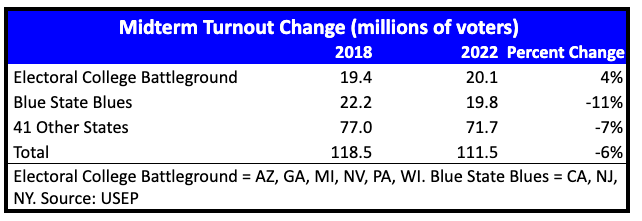
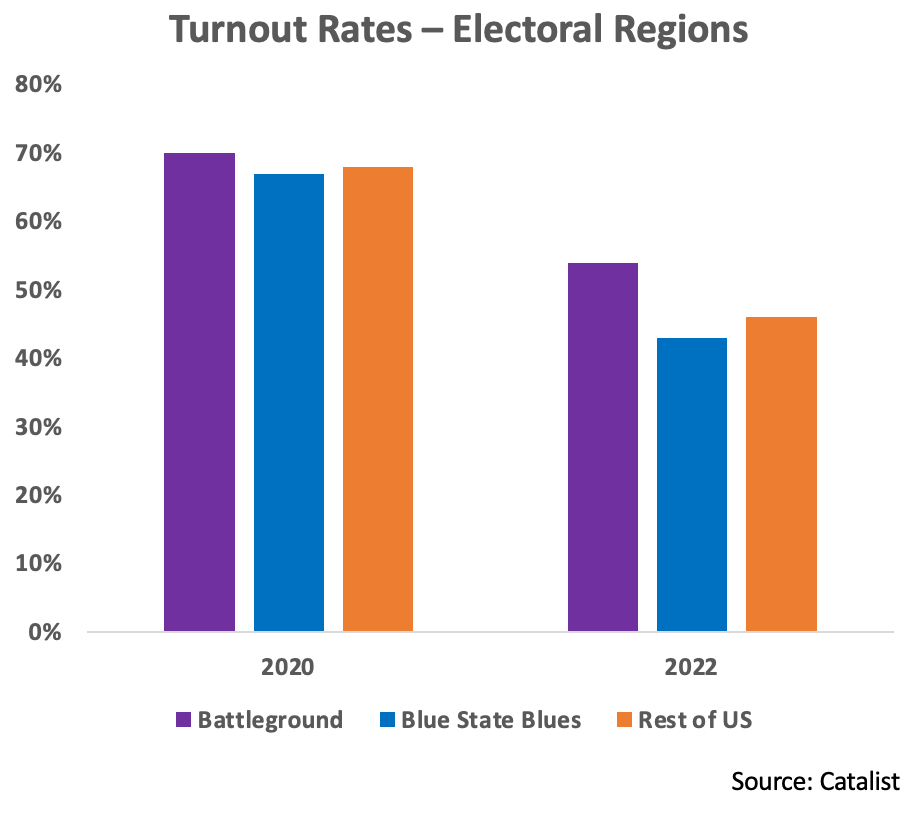
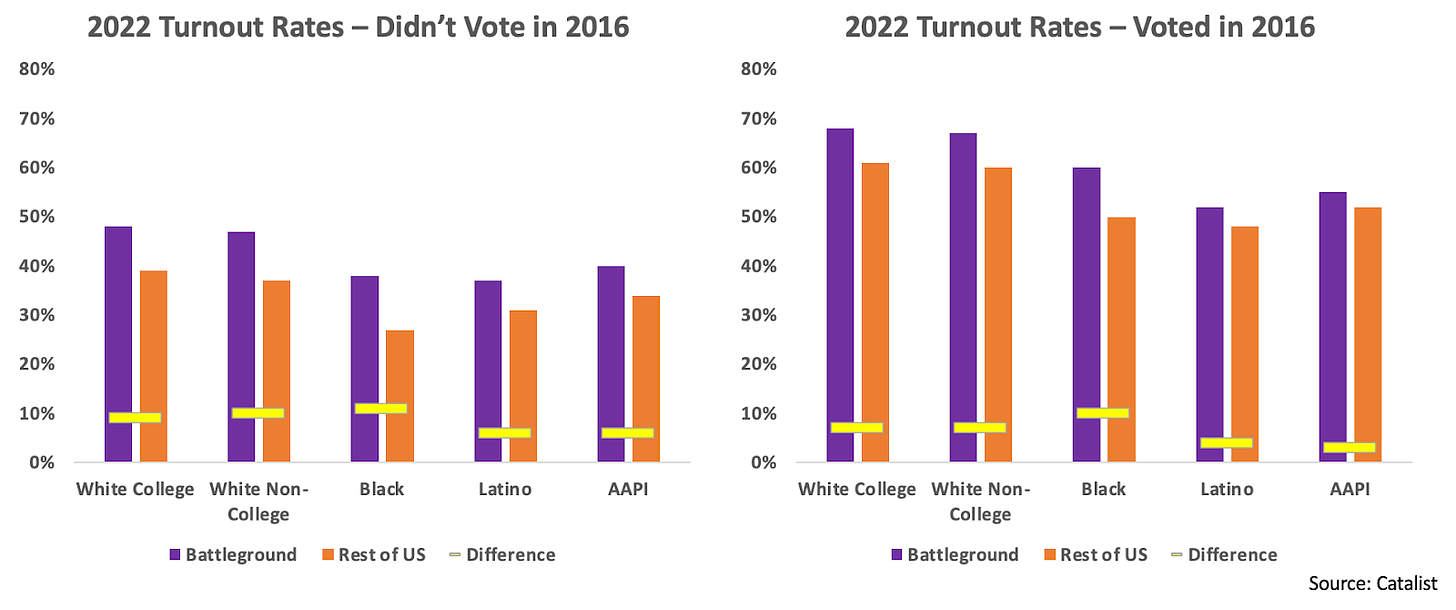
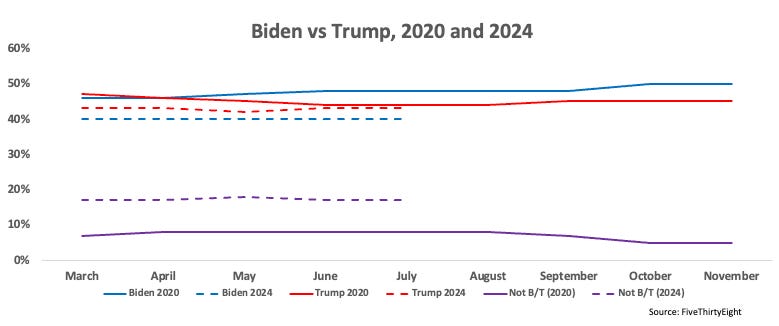
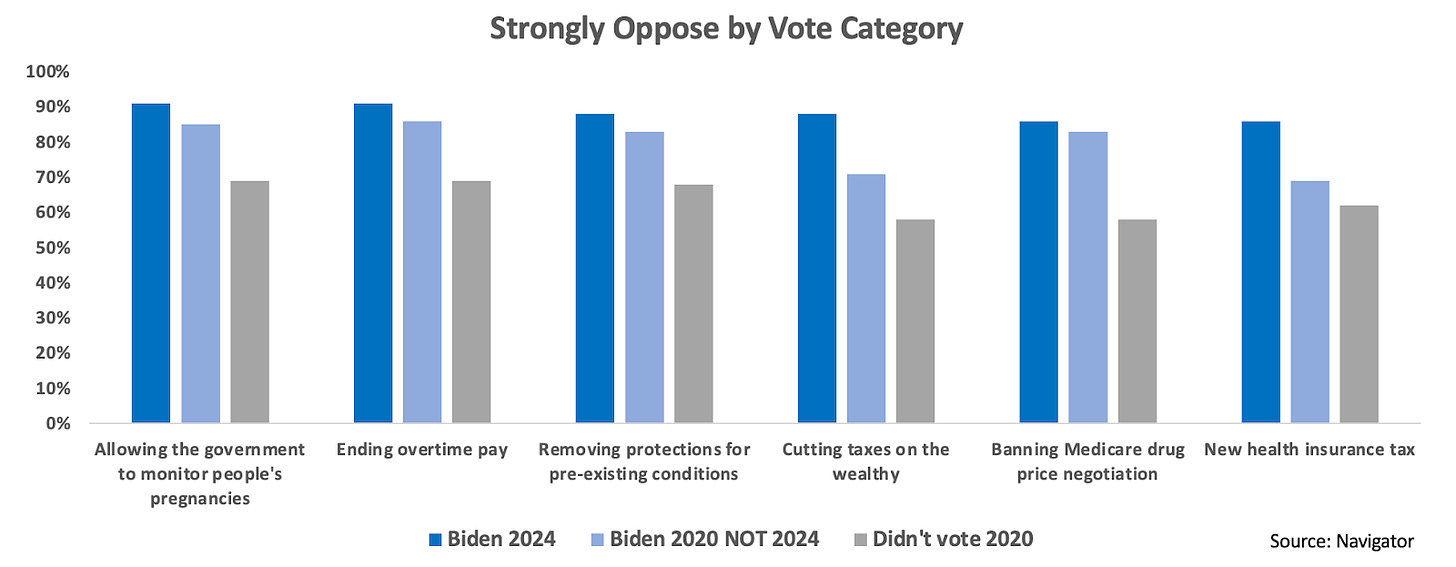
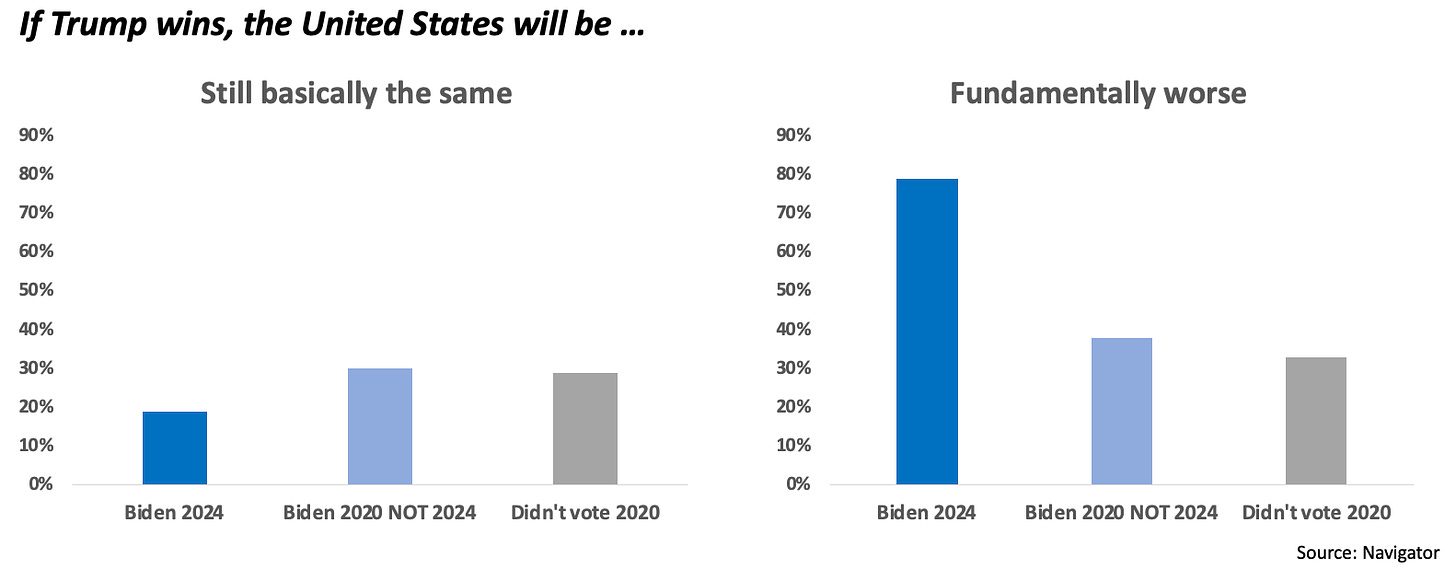
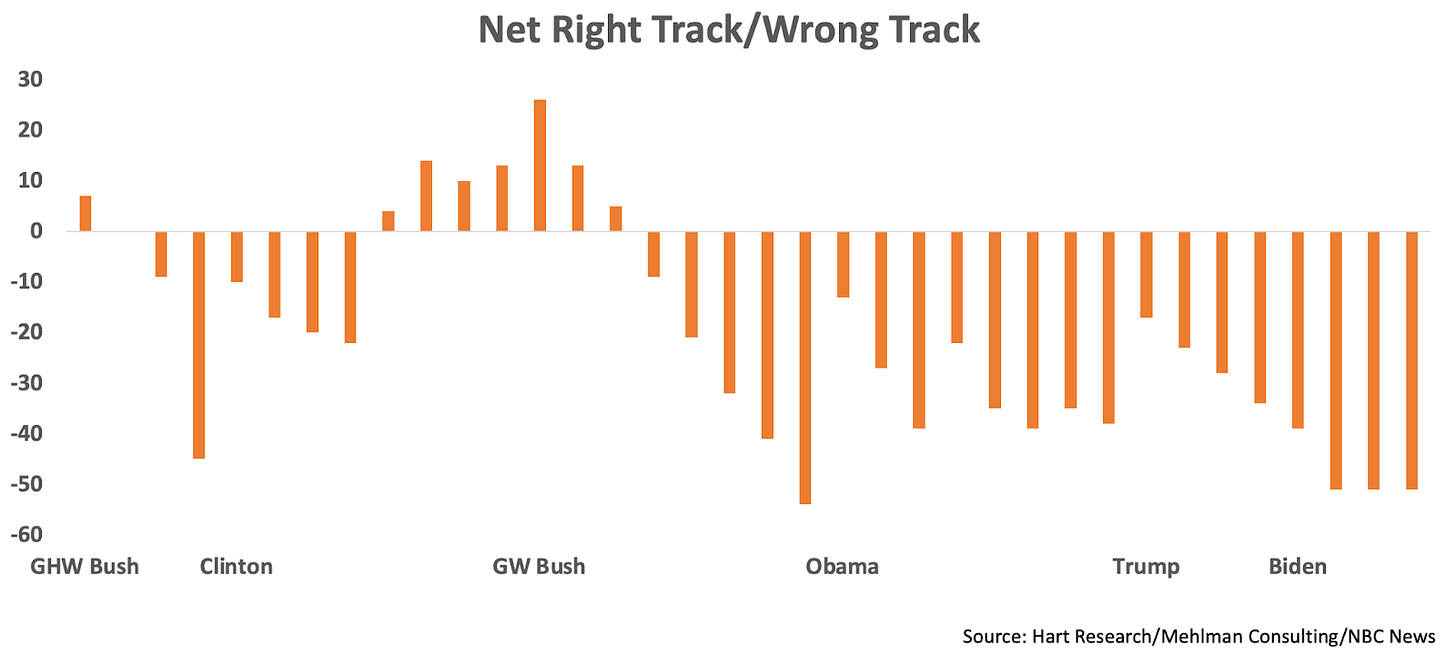
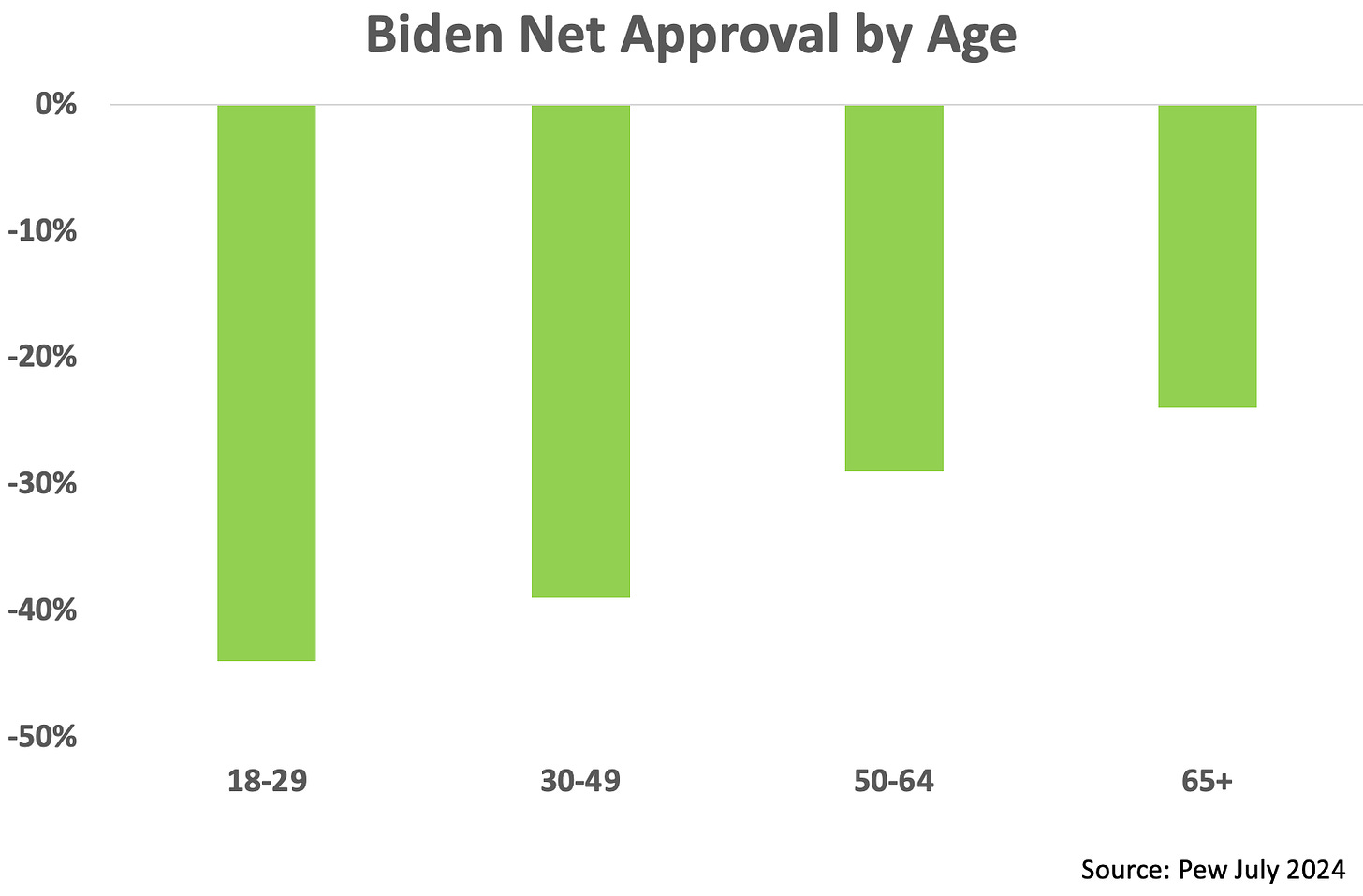
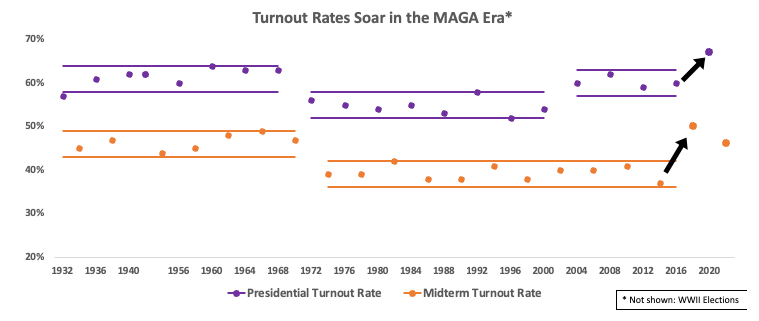

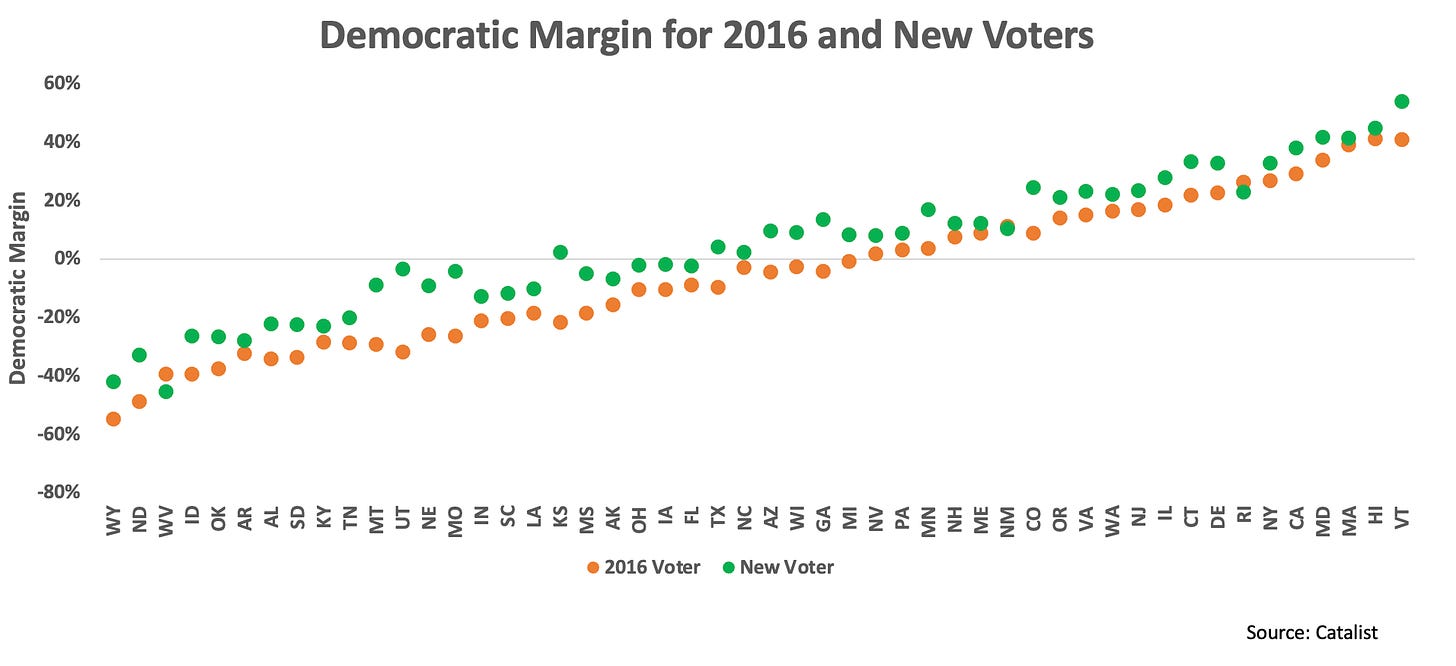

Spread the word